Pu’u La’au, Big Island, Hawaii
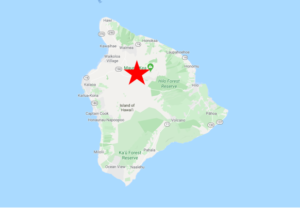
If you want to see a Palila, there is no better place than the Palila Forest Discovery Trail at Pu’u La’au. The remnants of native dry forest high on the western slope of Mauna Kea are the last stronghold of this unique honeycreeper, also home to a distinctive population of Hawaii Elepaio, and an abundance of Common Amakihi. Among the many introduced species present, Erckel’s Francolin is notably common and Japanese Quail is uncommon but significant because of its global decline.
Orientation
Directions
Pu’u La’au is on the western slope of Mauna Kea, about an hour’s drive (~40 miles) east of Kailua-Kona, and an hour’s drive (~45 miles) west of Hilo.
From Kona International Airport. Take Route 19 south for 1.2 miles, turn east on Kaiminani Drive, and go 3.6 miles to the T-junction with the Mamalahoa Highway (also part of the Hawaii Belt Road and Route 190).
Turn north on the Belt Road, go 19.4 miles to lower end of Daniel K. Inouye Highway, turn right and take this road for 9.6 miles to its junction with Saddle Road.
Turn north onto Saddle Road, go 1.1 miles, then turn right onto the gravel road (R-1) at the Kilohana Hunter Checking Station.
Depending on your vehicle and the current condition of the R-1 road, you will need to decide whether to park at the station and hike or drive all or part of the four miles up to the Palila Forest Discovery Trail at Pu’u La’au. The road’s condition varies. It has often been passable for standard passenger cars all the way up to Pu’u La’au, but it deteriorates and may require high-clearance.
From Hilo International Airport. Turn left (south) onto Kanoelehua Avenue (which is also the local segment of the Hawaii Belt Road), go one mile, turn right (west) onto Puainako Street (Route 2000). Remain on Puainako through its brief dogleg intersection with Komohana Street at the University of Hawaii – Hilo Campus, then continue west on Puainako which departs Hilo and becomes Saddle Road. Approximately 43 miles from the university, you will arrive at Kilohana.
Birdfinding
There are three main alternatives at Pu’u La’au: (1) drive up to the Palila Forest Discovery Trail; (2) park at Kilohana and hike up Pu’u Ahumoa; or (3) drive up until the road seems too risky for your vehicle, then park and hike up to either the Palila Forest Discovery Trail or Pu’u Ahumoa.
Palila Forest Discovery Trail. If your vehicle is suitable for the road conditions as you find them, probably the best alternative is to drive the four miles up to Pu’u La’au itself, where the Palila Forest Discovery Trail provides an easy option for a quiet walk through the dry forest. This is the most recommended way to find a Palila.
To reach the trail from Kilohana, follow the R-1 road uphill into the Ka’ohe Game Management Area, where the cinder cone Pu’u Ahumoa looms over the landscape. This area has a maze of dirt roads, but most of them are clearly less-traveled than R-1.
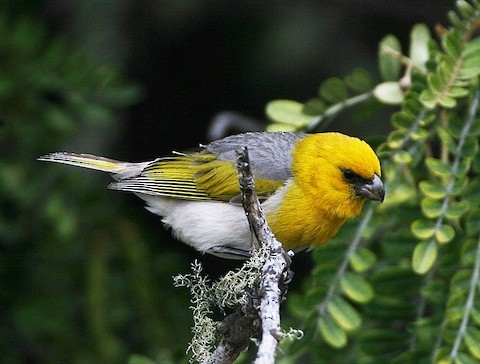
Male Palila at Pu’u La’au. © Michael Walther

For the first 1.5 miles, Pu’u Ahumoa will be on your right, until you reach a T-junction. Turning right here would take you up Pu’u Ahumoa. Turning left takes you toward Pu’u La’au.
Shortly after the turn, the road will fork, then fork again. Keep left at the first and right at the second. After the second fork, you will pass several more side-roads, but it should always be easy to recognize the larger road and remain on it.
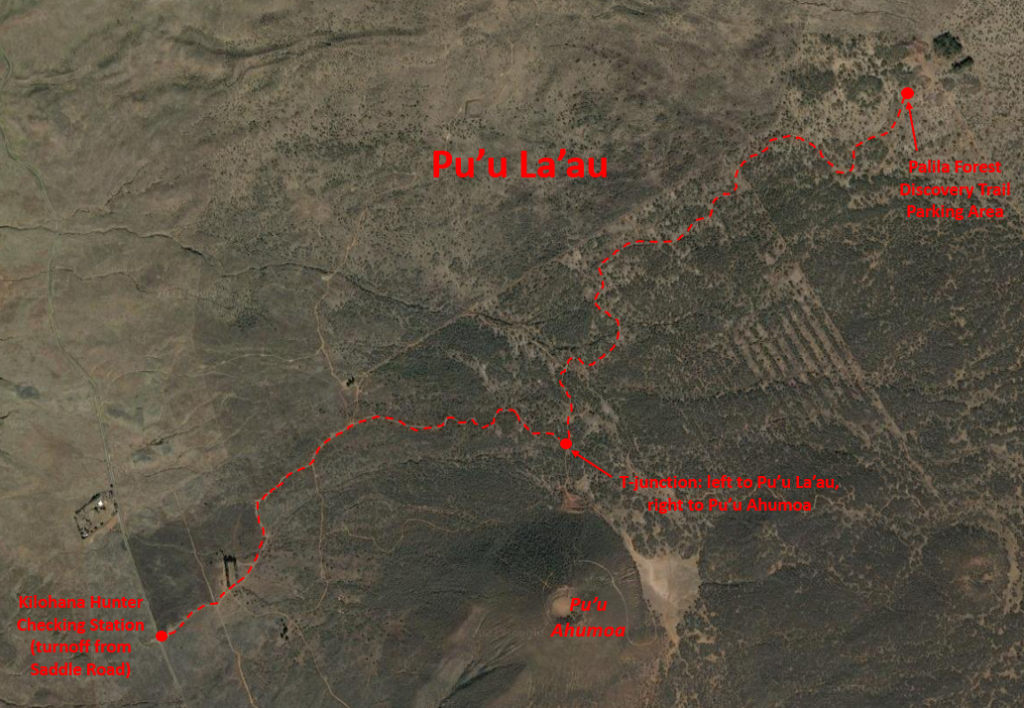
The Palila Forest Discovery Trail is a one-mile loop through the dry forest, with two side-trail segments that lead to scenic viewpoints. Palila is always present and can usually be found feeding on māmane seeds, although it may not always be conspicuous. Pu’u La’au is known for astronomically high densities of Common Amakihi. Also of interest, the local population of Hawaii Elepaio shows peculiarly pale plumage, and was initially considered a candidate for recognition as a distinct form or separate species, but has been shown more likely a localized color morph—based in part on the fact that this population also includes birds with typical plumage.

Common Amakihi is abundant at Pu’u La’au. © Karo Fritzsche
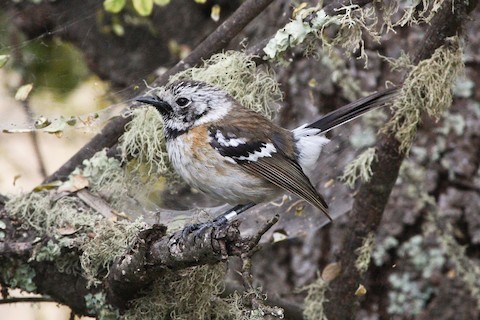
The Mauna Kea dry forest population of Hawaii Elepaio, bryani, has a distinctive pale plumage, but this seems to be color morph, not a fundamental difference. © Eric VanderWerf
“Hawaiian Short-eared Owl” is common enough to be expected on most visits, and the Hawaiian Hawk is seen occasionally.
Several gamebirds are common in the Pu’u La’au area. The commonest are California Quail and Erckel’s Francolin. Also fairly common are Wild Turkey, Black Francolin, and Common and Kalij Pheasants. Additional species that are likely to be present, but seen less often, are Chukar, Gray Francolin, and perhaps most interestingly, Japanese Quail—which has become globally rare in its native Asian range, making the small Hawaiian population more significant.
Other introduced birds that are generally common in the area include Eurasian Skylark, Japanese Bush-Warbler, Warbling White-eye, Chinese Hwamei, Red-billed Leiothrix, and Yellow-fronted Canary.
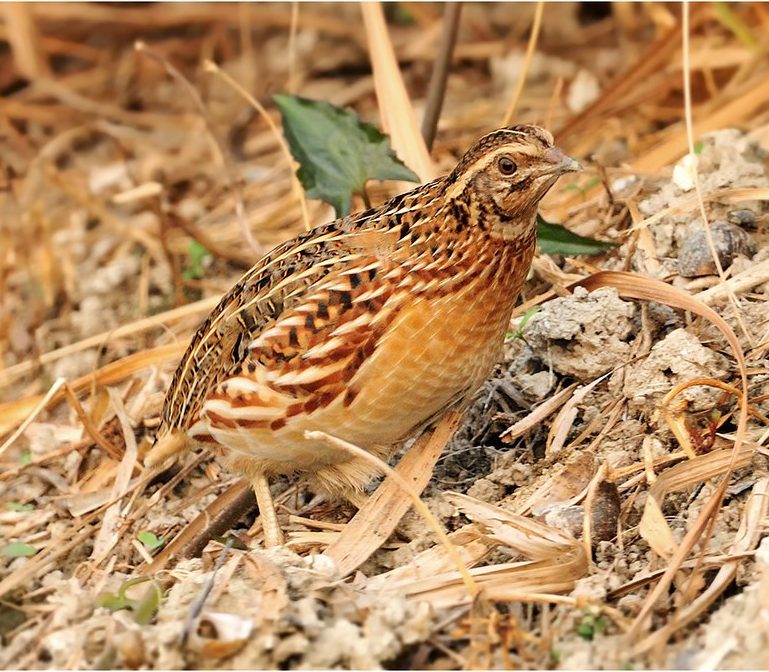
The Japanese Quail is declining across most of its native range—Pu’u La’au is its center of abundance in Hawaii. © oLDcaR
Pu’u Ahumoa. Another viable approach likely to yield most of the same species is to hike up the most prominent topographical feature in the area, the mostly wooded cinder cone, Pu’u Ahumoa. The first mile-and-a half of the R-1 road approaches this hill tangentially, and there are several side-roads and trails on which one could depart on foot and explore in that direction.
The existence of this alternative means that the success of a visit to Pu’u La’au does not depend entirely on the condition of the road and the clearance of the vehicle. If transportation to the upper trail is in doubt, there is a back-up plan.
Services
Accommodations
The Big Island has no shortage of accommodations along its coasts. More centrally located for access to Pu’u La’au, other sites along Saddle Road, and both coasts, are a handful of hotels in the town of Waimea, about 18 miles north of Kilohana. Reasonable options there include:
Waimea Country Lodge, 1-808-885-4100
Kamuela Inn, 1-800-555-8968
Notes
Hazards & Hassles
Guns. The Ka’ohe Game Management Area is popular with hunters, so don’t be too alarmed if you hear gunshots or encounter humans bearing firearms, but try not to look like a deer—or a sheep, goat, or turkey, etc.
Weather. Although the habitat of Mauna Kea’s western slope is classified as dry forest and the area is climatically semi-arid, it also receives regular precipitation. Much of this is in the form of either fog or mist. The area is at a high enough elevation (6,000-7,500’) to be consistently cold overnight and to be brisk at any time of day, depending on the weather. When the fog rolls in, which it often does, it can be thick enough to frustrate navigation—so it is important to remain oriented and remember exactly how to return to your vehicle or a known road.
Links